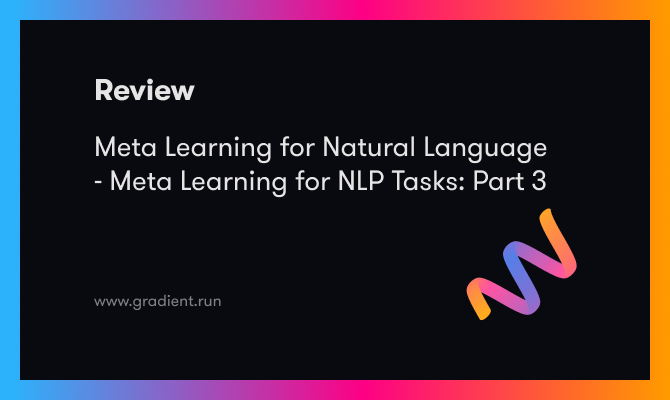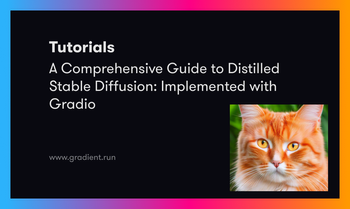In this section, we'll see examples of the most widely used meta-learning techniques for natural language processing (NLP) applications. Only the most significant trends are discussed.
Learning to Initialize
The process of gradient descent starts with a set of parameters (θ0) and updates these parameters iteratively based on the directions provided by the gradient. Meta learning approaches aim to improve data efficiency and generalizability by learning algorithms for learning. Learn to init approaches, which specifically focus on learning the parameters (θ0) for gradient descent are a subset of meta learning approaches. In these approaches the meta parameters (φ) that need to be learned correspond to the parameters (θ0) for gradient descent or φ = θ0. Notable examples of learn to init approaches include MAML (Finn et al., 2017) and its first order approximation, FO MAML (Finn et al., 2017), as well as Reptile (Nichol et al., 2018).
Learning to Initialize v.s. Self-supervised Learning
There are two methods, in NLP known as "learning to initialize" and "self supervised learning." The first method focuses on training a model to acquire good initial weights for a neural network. This aids in convergence during training and potentially improves performance. The second method involves training a model on a task that doesn't require labeled data. This enables the model to learn representations of input data, which can be utilized for tasks.
Both approaches have their strengths and weaknesses. Learning to initialize is particularly advantageous when there is limited labeled data since it allows the model to learn efficiently from the existing data. Conversely, self supervised learning proves valuable when abundant unlabeled data is accessible. It empowers the model to learn from data and potentially enhance its performance on tasks. Researchers in the field of meta learning, for NLP are currently investigating both approaches while also striving to develop techniques that combine them or address their limitations.
Learning to Initialize v.s. Multi-task LearningLearning
Multi-task learning is another way to initialize model parameters, which usually serves as the baseline of learn-to-init in the literature. In multi-task learning, all the labelled data from the meta-training tasks is put together to train a model.
Meta-learning and multi-task learning use examples from meta-training tasks, but use distinct criteria for training. Learn-to-init seeks to identify these initialization parameters by iteratively training and assessing the model on the support sets and the query sets, respectively. Multi-task learning, on the other hand, does not account for the fact that the initialization parameters would be updated further throughout training. Learn-to-init has been found to perform better than multi-task learning in many different scenarios. Meta-learning is more computationally intensive than multi-task learning optimization.
Three-stage Initialization
Despite its differences, learn-to-init, multi-task, and self-supervised learning may be combined to benefit from each method's strengths. The "three-stage ini- tialization" described below is a standard method for combining all three procedures.
a) To begin, use unlabeled data for model training with self-supervised learning. It is not often designed to solve the NLP issue at hand.
b) The self-supervised model is fine-tuned by multi-task learning. Multi-task learning focuses on solving the NLP issue at hand but ignores the gradient descent updating technique.
c) Finally, learn-to-init, which finds the initial parameters suitable for update, is used to fine-tune the multi-task model
Learning to compare
The approach known as Learning to Compare, within the field of natural language processing (NLP) and particularly in meta learning is a technique aimed at enhancing the performance of few shot learning tasks. Few shot learning involves training models to learn from labeled data and generalize well when faced with new unseen examples. The Learning to Compare method tackles this challenge by training models to compare and classify instances based on a set of labeled examples.
In NLP, there are ways to implement the Learning to Compare method. One used approach is through siamese networks or triplet networks. Siamese networks consist of two networks that share weights. These networks generate embeddings for each input text, which are then compared using a distance metric to determine their similarity.
On the other hand, triplet networks expand on this idea by incorporating a text instance. The network takes in an anchor text, a text ( similar to the anchor) and a negative text (dissimilar to the anchor). The objective is to minimize the distance between the anchor and positive examples while maximizing the distance, between the anchor and negative examples. The Learning to Compare approach trains models to analyze text examples and develop a measure of similarity. This enables the models to make predictions even when there is limited labeled data, in tasks related to Natural Language Processing (NLP).
Neural Network Architecture Search
Neural Architecture Search (NAS) is a technique used in the field of Natural Language Processing (NLP) to help with meta learning. The main goal is to let the system figure out the best neural network structure for whatever NLP task you're working on, instead of having to design it yourself.
Basically, it tries out a bunch of different network setups within some limits you set and sees which one works the best. The options it tests usually include standard building blocks like recurrent layers. The idea is to take humans mostly out of the equation when it comes to coming up with neural network architectures. This way, you can explore a wider range of possibilities, than you'd probably think of on your own.
In theory, NAS can improve how well NLP models perform on certain tasks. But it takes a lot of computational power and time to run all those tests and training rounds. Evaluating the NAS methods can also get pretty complex. Using NAS for meta learning in NLP seems promising, as It can automate finding network designs tailored to specific NLP tasks better than a human could. This might lead to better performance.
Some popular neural architecture search algorithms
There's a bunch of popular algorithms used for Neural Architecture Search in Natural Language Processing. Let me break down some of the big ones:
- Random Search - This randomly tries out different network architectures from the search space. It tests a wide range of choices, but may not be the efficient way to find the best design.
- Reinforcement Learning Methods - These use reinforcement learning to train a controller network that generates the architectures. The controller network is trained to maximize some reward based on how well the designs it creates performs on a validation dataset.
- Evolutionary Algorithms - Inspired by evolution in nature, these keep a population of candidate architectures. Through stuff like mutation and crossover, new architectures are created over time. The fitness of each architecture is evaluated based on its performance on a validation set.
- Bayesian Optimization - This sequential optimization method uses a probabilistic model to predict how well architectures will perform. It selects architectures for evaluation based on an acquisition function that balances exploration and exploitation.
- Gradient-based Methods - These utilize gradient information to optimize the search. They usually involve differentiable operations and use gradient descent to update the architecture parameters.
These NAS algorithms play a crucial role in NLP research and development, aiding in the discovery of optimal architectures for various tasks.
Meta-learning for Data Selection
In the field of natural language processing (NLP), meta-learning for data selection aims to enhance the efficiency and generalizability of data by utilizing knowledge gained from previous tasks or datasets. By studying a diverse range of tasks or datasets, a meta-learning model can identify the underlying structure and patterns that are pertinent to a specific NLP task. One approach to meta-learning for data selection involves using meta-features or meta-labels to characterize the properties of different datasets or tasks.
These meta-features can encompass linguistic properties, domain-specific information, or statistical measures. The meta-learning model then learns to predict the performance of a given dataset or task based on these meta-features. Another approach is to use meta-learning algorithms, such as reinforcement learning or evolutionary algorithms, to optimize the process of data selection. These algorithms can dynamically select subsets of data or assign varying weights to different datasets based on their relevance to the target NLP task.
Conclusion
Meta learning, in the field of Natural Language Processing (NLP) is an emerging area that aims to improve the performance and efficiency of NLP models. It achieves this by leveraging knowledge gained from previous tasks or datasets.
- Effectiveness in Various Aspects:Meta learning approaches in NLP aim to enhance algorithms in areas, such as improving data efficiency and increasing generalizability. By learning from tasks or datasets, meta learning models can identify patterns and structures that are relevant to specific NLP tasks.
- Boosting Data Efficiency: Meta learning plays a role in enhancing data efficiency by allowing models to learn from a number of examples. Meta learning algorithms learn how to generalize from a set of tasks enabling them to adapt to tasks, even with limited training data.
- Few shot Learning: Meta learning proves valuable for few shot learning tasks where the objective's to train a model that can adapt well to new tasks with minimal training data available. This becomes advantageous when new tasks are frequently introduced making it impractical to collect amounts of labeled data for each task.
Reference












